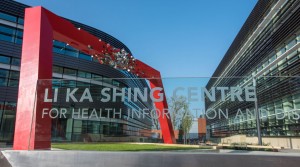The Big Data Institute, phase two of the Li Ka Shing Centre for Health Information and Discovery at Oxford University, was officially unveiled on Tuesday, May 16. The ceremony was attended by the Rt Hon Philip Hammond, Chancellor of the Exchequer, Lord Chris Patten, Chancellor of Oxford University, and Mr. Li Ka-shing, Chairman of the Li Ka Shing Foundation.
Developed with the support of a £20m gift from the Li Ka Shing Foundation, the Centre for Health Information and Discovery incorporates two related research institutes at the heart of Oxford University’s major biomedical campus in Headington. The two research institutes, the Target Discovery Institute (TDI) and the Big Data Institute (BDI), will lead the development of new types of research activity in the University.
Mr. Li said, “I believe the work done here will make history, and will make miracles. I am very honoured to have been able to join Oxford University in this noble enterprise, and consider myself truly privileged to have been able to play a part in enabling the miracles and history that will be made here.”
The Target Discovery Institute, Phase One of the Centre for Health Information and Discovery, was opened in May 2013 with Mr. Li and former Prime Minister David Cameron in attendance at the ceremony. The TDI uses high-throughput biology to define better drug targets in collaboration with industry, addressing a critical ‘blockage’ in the existing drug development process. The second phase will focus on the analysis of large data sets, bringing together leading researchers from multiple disciplines, speeding up both our understanding of diseases and the development of new treatments for conditions including cancer and Alzheimer’s disease.
More than six hundred scientists will be based in the centre, from a wide range of research areas, working to define disease more accurately, identify targets for new drugs, and to help us to understand how disease responds to treatment. Molecular and cell biologists, chemists, statisticians, computer scientists, informatics specialists, engineers and clinical scientists will all be housed under the same roof, to improve the collaboration between different teams.
Sir John Bell, Regius Professor of Medicine at the University of Oxford, said: “Technological advances have exponentially increased the information we have about what happens in a variety of disease states. Some of this comes from health care records and some from analysing patient samples. Being able to efficiently interrogate this data will play an increasing role in both research and treatment development in the coming years, and by bringing together world-leading research teams under one roof we will be able to accelerate this process significantly.
“The funding from the Li Ka Shing Foundation demonstrates the importance of continual investment in our research and development facilities if we are to keep pace with technological advances.”
About Oxford University’s Medical Sciences Division
The Division is one of the largest biomedical research centres in Europe, with over 2,500 people involved in research and more than 2,800 students. The University is rated the best in the world for medicine, and it is home to the UK’s top-ranked medical school. From the genetic and molecular basis of disease to the latest advances in neuroscience, Oxford is at the forefront of medical research. It has one of the largest clinical trial portfolios in the UK and great expertise in taking discoveries from the lab into the clinic. Partnerships with the local NHS Trusts enable patients to benefit from close links between medical research and healthcare delivery. A great strength of Oxford medicine is its long-standing network of clinical research units in Asia and Africa, enabling world-leading research on the most pressing global health challenges such as malaria, TB, HIV/AIDS and flu. Oxford is also renowned for its large-scale studies which examine the role of factors such as smoking, alcohol and diet on cancer, heart disease and other conditions.




